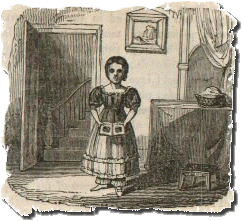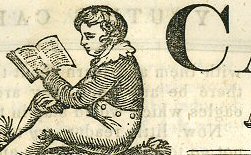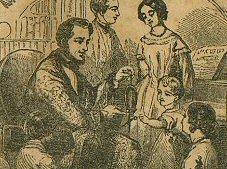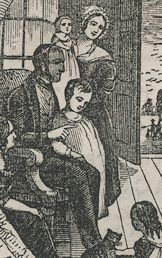NINETEENTH-CENTURY AMERICAN CHILDREN & WHAT THEY READ:
Some of Their Magazines
About 430 periodicals for children were founded in the U. S. before 1873. Learn more about them at “American Children’s Periodicals, 1789-1872,” an ever-growing descriptive bibliography.
Works on pre-1873 American children’s periodicals are listed or transcribed in a separate bibliography.
Puzzles appeared in most nineteenth-century American magazines for children. The Puzzle Drawer is a selection of puzzles printed in Woodworth’s Youth’s Cabinet and Robert Merry’s Museum. They range from the easy to one designed to be impossible. Try your wits! (And your patience!)
Originally an anti-slavery newspaper, the Youth’s Cabinet changed drastically when it was purchased by Francis C. Woodworth in 1846. Woodworth’s Youth’s Cabinet focused on geography and history, or on Christian morality. With its pages of dense text and its insistence that every subject be viewed through a narrow moral aperture, the magazine is a bit difficult to warm up to.
“Uncle Frank” was Francis C. Woodworth, whose articles on the “corrupting” influence of fiction appeared in several magazines.
Like Robert Merry’s Museum, the Cabinet occasionally printed letters from its subscribers; I’ve selected the most interesting ones. They describe the inconvenience of long skirts, going to school by sleigh, chasing bears in Michigan, and how to make a cornstalk fiddle.
“Bones of a Mastodon” (July 11, 1839), reprinted from the Pittsburg Advocate, is probably the first description of its bones published for American children—though “description” doesn’t imply that readers would have any idea of how the animal would look. While the Cabinet was one of the few early American children’s periodicals publishing works on fossils, it was up to Robert Merry’s Museum to show a mastodon skeleton.
“Organic Remains,” by Josiah Holbrook (December 9, 1841), showed young readers pictures of fossils and assured them that the study of geology was “fashionable, interesting, and highly practical.” It was one of the few works on fossils in early American works for children.
“The Untidy Girl” (February 1847) warns girls that untidiness may cost them a husband.
“Professor Morse” (April 1848) allows Francis Woodworth to discuss the inventor across the street, advertise the engraver next door, and indulge in a little weird science that had to be corrected a few months later.
“Wood Engraving” (April 1848) is basically an informative advertisement for the company that provided many of the Cabinet’s illustrations.
“A Correction” (September 1848) retracts a statement in an earlier article on Samuel Morse, that telegraph wires would reduce casualties by lightning strikes.
“The Skater’s Song” (January 1849) is a cheery evocation of skating.
“William, the Negro Boy” (April 1849), by Jane L. Gray, extolls the heroism of William Patterson, who apparently died in Easton, Pennsylvania, while saving other boys from drowning. The author’s lapses into condescension tell us something about 19th-century attitudes … and bad poetry.
“Adventures with Ghosts” (May 1850), by Mrs. Hall, provides rational explanations for a couple hauntings.
“Amy’s Holiday” (September 1850) blends several moral lessons and gives a glimpse of the seamier neighborhood in a small New England town.
“The Arabian Nights” (September 1850) is an indictment of imaginative works for children.
“Clara Sinclair” (September 1850), by Caroline Gilman, focuses on why a girl should learn mathematics.
“Laughing Bill” (November 1850) cautions readers about giving in to peer pressure.
“Hieroglyphical Letter to the Editor” (February 1851), by Susanna Newbould, is an elaborate concoction of visual puzzles and puns.
“The Spelling Lesson” (February 1851) is a humorous story of “spelling" and “spelling,” from a book by a teacher.
“A Siberian Winter” (August 1851) is apparently a selection from a travel book, detailing the difficulties of 19th-century travel through a frozen landscape.
“The Busy Knitter” (August 1851), by William Oland Bourne, is a poem describing a little girl knitting, in a lively and catchy rhythm.
“The Bloomer Dress” (October 1852) is a somewhat amused exploration of the vagaries of fashion.
This Advertisement for Tuttle’s Emporium (January 1854) was written so that the list of glories to be found in Tuttle’s story can be sung to the tune of “Yankee Doodle.” (Really!)
“Curiosities of Sleep” (April 1854) is an unscientific mish-mash of anecdotes and urban legends.
“The Miser and His Dinner” (September 1854) is atypically funny and non-temperance.
“The Four Wills” (September 1854) is an odd and sometimes humorous little piece of New-Englandiana involving two wills, two Wills, a little romance—and an author backpedaling from the implied lesson of an entertaining story.
“A Happy New Year” (January 1856), by Francis Forrester, cheerfully greets the new year, with its message of hope. New Year’s Day was one of the major gift-giving holidays in 19th-century America.
“Diligent David” (February 1856), by Francis Forrester, provided young 19th-century readers with a paragon of studious virtue—and gives 20th-century readers a glimpse of what the 19th-century wild bunch did on its nights out.
“Cross Questions and Crooked Answers” (February 1856), by Susanna Newbould, describes the rules of a truly silly game, and reminds us that children have been children in every century. The game originated sometime before 1836; it is played in a story which appeared in the 1837 volume of The Pearl; or, Affection’s Gift.
In 1856, Francis Woodworth published several pieces in connection with his trip to the embattled Kansas Territory, as he traveled with the Kansas Committee of Investigation, from Washington, DC. “Uncle Frank in Kansas” (June 1856), includes a description of the Territory, with some words about the Shawnee forced to emigrate there. “The Prairies of Kansas” (November 1856) describes his journey from Lawrence to Leavenworth, noting casually that “Almost every body in Kansas goes armed.”
“Thanksgiving Memories” (October 1856), by Francis Woodworth, is the rambling account of childhood Thanksgivings in Connecticut, very much not the holiday Americans celebrate now.
An ambitious mixture of fiction, fact, and illustrations, the Young People’s Magazine was edited by the popular Seba Smith. While it didn’t last long, its hand-colored plates and wide variety of material make for lively reading today.
Publicly unprofitable, the Mirror offered pieces on a wide variety of subjects. While the editor never lost an opportunity to complain about his financial losses, he still managed to fill the magazine with illustrations and lively pieces.
“Geology” (March 1849) lists the wide variety of animals to be found in fossil form; it’s one of the works on fossils published in early American works for children.
“Fossil Foot-Prints” (December 1849) is a reprinted piece showing apparent human footprints in fossil rock found near St. Louis, Missouri, early in the century. Most works on fossils appearing in early American works for children didn’t try to place humans into the geologic record.
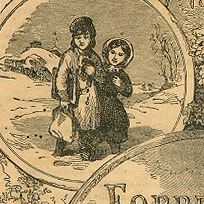
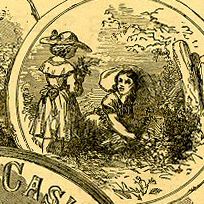
MONTHLY INSTRUCTOR AND FIRE SIDE COMPANION • FORRESTER’S PLAYMATE • YOUTH’S CASKET AND PLAYMATE (July 1854-after April 1867)
Whatever its title, this magazine founded and edited by “Mark Forrester” (Dexter S. King) offered readers stories, poems, and nonfiction articles on a variety of subjects.
To “Nineteenth-Century American Children & What They Read”
Some of the children | Some of their books | Some of their magazines
Some works for adults, 1800-1872
